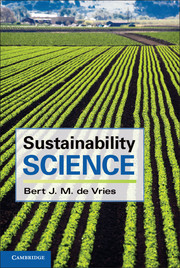Book contents
- Frontmatter
- Contents
- Preface
- 1 Introduction
- 2 The System Dynamics Perspective
- 3 In Search of Sustainability: Past Civilisations
- 4 The World in the Past 300 Years: The Great Acceleration
- 5 Sustainability: Concerns, Definitions, Indicators
- 6 Quality of Life: On Values, Knowledge and Worldviews
- 7 Energy Fundamentals
- 8 On Knowledge and Models
- 9 Land and Nature
- 10 Human Populations and Human Behaviour
- 11 Agro-Food Systems
- 12 Renewable Resources: Water, Fish and Forest
- 13 Non-Renewable Resources: The Industrial Economy
- 14 Towards a Sustainable Economy?
- 15 Outlook on Futures
- Glossary
- References
- Index
- Plate Section
- References
5 - Sustainability: Concerns, Definitions, Indicators
- Frontmatter
- Contents
- Preface
- 1 Introduction
- 2 The System Dynamics Perspective
- 3 In Search of Sustainability: Past Civilisations
- 4 The World in the Past 300 Years: The Great Acceleration
- 5 Sustainability: Concerns, Definitions, Indicators
- 6 Quality of Life: On Values, Knowledge and Worldviews
- 7 Energy Fundamentals
- 8 On Knowledge and Models
- 9 Land and Nature
- 10 Human Populations and Human Behaviour
- 11 Agro-Food Systems
- 12 Renewable Resources: Water, Fish and Forest
- 13 Non-Renewable Resources: The Industrial Economy
- 14 Towards a Sustainable Economy?
- 15 Outlook on Futures
- Glossary
- References
- Index
- Plate Section
- References
Summary
Introduction
Historical accounts are given from a particular vantage point. Ours is the emerging field of Sustainable Development research in a Global Change context (Turner et al. 1990; Costanza et al. 2007). It explores human development and the planetary boundaries within which it unfolds (Rockström et al. 2009). The dominant frame is given by the natural sciences and their concepts, methods and theories. Their findings represent the prevailing outlook on the world in Western, and increasingly other, societies and are at the core of university curricula associated with Modernism. It is, therefore, instructive to briefly introduce the history of the ideas behind this worldview and its essential tenets. How does modern man see earth, life on earth and man himself after these 300 years of scientific advances and economic growth? Such a reflection also makes apparent the limitations of this worldview. Clearly, science and technology have liberated us to a large extent from the controls of Nature. There is no need anymore for Gods who have to be begged for help with prayers, virtues and sacrifices. At the same time, there is growing discontent with the scientific, modernist outlook. A primarily natural science interpretation of problems of development and sustainability and their solutions meets with opposition and critique. Chapters 6, 8 and 10 explore these critiques in more depth.
Against this background, the emergence of environmental concerns and the heightened interest in the notion of (un)sustainable development has to be understood. The second part of this chapter briefly recounts the pedigree of the concept and emphasises the historical context and changes. I abstain from a rigid definition and instead, in the last section, focus on indicators of (un)sustainability and (un)sustainable development that are proposed in order to make the concept more operational.
Information
- Type
- Chapter
- Information
- Sustainability Science , pp. 117 - 145Publisher: Cambridge University PressPrint publication year: 2012
